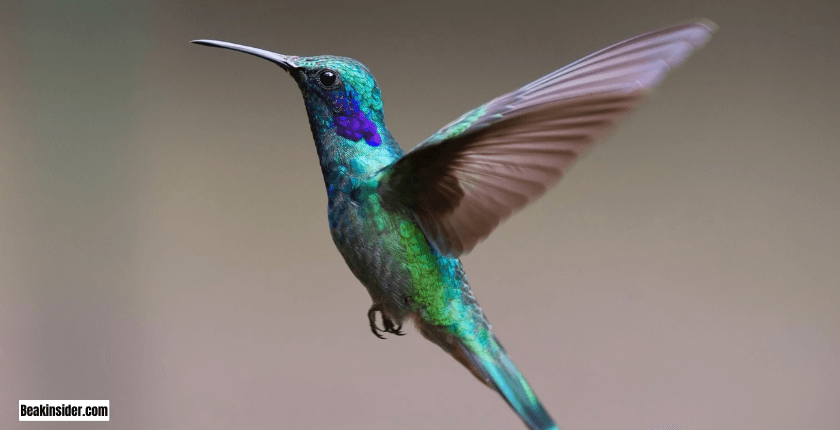Hummingbirds are most famous and fascinating creature found worldwide. Its beak size is very large. It is 4 inches or 10 cm long. They are famous for their hovering abilities. They have beautiful plumage and different color and sized beak. Another beautiful feature of hummingbird is that they have large and elongated beak. It helps them to reach the nectar of various flowers. Their beak size vary across all species.
In this article I will tell you:
- The average length of hummingbirds beak
- Why their big size varies?
- Role of their beak in searching the food
- Autonomy of hummingbirds beak
- Length of longest species of hummingbirds beak
- Frequently asked questions
Let’s start without wasting time!
The Average Length of a Hummingbird’s Beak
Hummingbird has a very large number of species. Their number reaches 300 species. Their beak size vary across species. The length of hummingbird is 2 inches or 5 cm. Although, their beak size fluctuates across species. Some species of hummingbird have very small beaks. But one of the famous species named as sword billed hummingbird has a very large beak size. Their beak size is one third of their whole body.
- Smallest Beak Length: The smallest hummingbird is Bee hummingbird. Roughly it’s beak has a length of 0.7 inches or 1.8 cm.
- Longest Beak Length: Hummingbird having the largest beak is Sword billed hummingbird. It has an extra ordinary length of 4 inches or 10 cm. Their body size is smaller than its beak length.
Why Hummingbird Beak Length Varies

Hummingbirds have unique structure. It is design to fulfill their ecological needs and to access there food. Different hummingbirds develop themselves according to their food needs and weather etc. If you compare hummingbird beak with food, then it will become an example of coevolution.
In this section I will tell you; how much hummingbirds beak is helpful in fulfillment of their food needs.
Flower Specialization
Generally, hummingbirds rely on flowers for their food. They are design to reach the depth of flowers. Their beak length correlates with the shape of flowers. Flowers that has tubular shape. It is ideal for the species of hummingbirds having long beaks. While the species that have short beaks, rely on flowers having less depth. It is helpful in reducing competition among species of hummingbird.
- Longer Beaks: Species like sword billed hummingbird rely on flowers. They like flowers having long corollas, insects for their food.
- Shorter Beaks: Hummingbird that have short beak rely on small flowers to reach nectar.
Feeding on Nectar
As you know that hummingbirds have a long beak that help them to suck the nectar from the flowers. Through their long beak, they reach depth of the flowers. Their tongue extends beyond the tip of flowers and helps to lap up the nectar. Actually beak doesn’t absorb the nectar itself, it acts as a tool to reach the food.
Mating Displays
Despite communication, beak of hummingbird is very important in courtship and meeting rituals. A longer and stronger beak indicates genetic fitness of them. Species of hummingbirds use beaks to display their beauty and attract their mates.
Anatomy of a Hummingbird’s Beak

When you think about the features of birds, beak is the most common feature. Beak is structured according to their environment to support their lifestyle, feeding etc. It also plays an important role in communication and catching the small invertebrates.
Beak Composition
Like many other birds, beak of hummingbird is made up of a bony structure. Keratin covers this structure, an essential compound for living organisms. Although, they have a very large beak, but it is lightweight. Its design shows precision and as compared to strength.
Nostrils
Hummingbird has a small nostril at the base. Like beak, nostrils are also design according to their adaptation. These nostrils are helpful in respiration. They play active role during flight of hummingbird by keeping a large amount of energy.
Flexible Lower Beak
Many birds have fixed to lower beak. But hummingbird have movable and flexible beak (lower mandible). It is a unique feature that is found in hummingbirds. This flexibility aids hummingbird to capture more insects in air. They can adjust their lower mandible to reach the food.
The Longest Hummingbird Beak: Sword-billed Hummingbird

Sword billed hummingbird is the species that has longest beak in the hummingbirds. It scientific name is Ensifera ensifera. It’s beak size is larger than its body size and across all the hummingbird species. Their body is 3.5 inches or 9 cm long. But their beak has an extraordinary length of 4 inches or 10 cm.
Unique Feeding Adaptations
Sword billed humming bird has unique feeding adaptations. They have a long beak that reaches the depth of tubular flowers, where many other birds are unable to reach. Pollination is possible for the flowers by hummingbirds, during courtship rituals. Their beaks are design to reach the hidden nectar from the flowers.
Challenges of a Long Beak
As you know that the long beak of sword build hummingbird is a good tool to reach nectar from the flowers. But it also forms many challenge for hummingbird. Like many other birds, they don’t use their feet to clean the feathers. They use their beaks. They have long beak that makes the whole preening process difficult for them.
Frequently Asked Questions (FAQs)
Write Fun Facts About Hummingbird’s Beak?
- A hummingbird’s beak isn’t a straw. Their tongues rapidly flick in and out. They use capillary action to draw up nectar.
- Their beaks are slightly flexible. Some species having curved shape beaks to help them in accessing deep flowers.
- Each species has a uniquely shaped beak. It matches the flowers they prefer.
- Male hummingbirds even use their beaks to impress females.
What Is The Beak Of Hummingbirds Called?
A hummingbird’s beak is called a bill or beak. It is perfectly adapted for nectar-feeding and insect-catching. It is long and slender. It varies in shape depending on the species. It allows them to access different flowers. Hummingbirds have specialized bills designed for precision feeding.
Conclusion
Hummingbirds beak is structured in a way that suits their ecological niche. It has a remarkable adaptation. Humming bird has a long, cylinder, short, thin and stout beak. It serves as a tool for feeding, survival, courtship rituals etc.
The longest species of hummingbird is sword billed hummingbird. It have a very large beak. It shows fascinating relationship between bird and the pollination process. As you know hummingbirds beak shows diversity and complexity. It’s beautiful beak is a good way to attract their mates.
If you find any difficulty in content while reading, ask me in the comment box, I will reply to you soon. Thanks for reading!
Related Articles |

I’m Amna, and I absolutely adore birds, especially parrots. I’ve been immersed in the world of these colorful feathered friends for over 10 years. While I’m not a bird doctor, I’ve gathered a wealth of knowledge on how to care for and understand them.
My experiences extend to various bird species like parrots, macaws, cockatoos, canaries, and finches. In addition to my personal adventures with birds, I’ve dedicated time to volunteering at a local bird rehabilitation center.
My true passion lies in sharing what I know about parrots and birds with you. Through my articles, I aim to share the information you need to provide the very best care for your avian companions. So, let’s embark on this journey together and make your feathered friends’ lives as joyful and healthy as possible!

